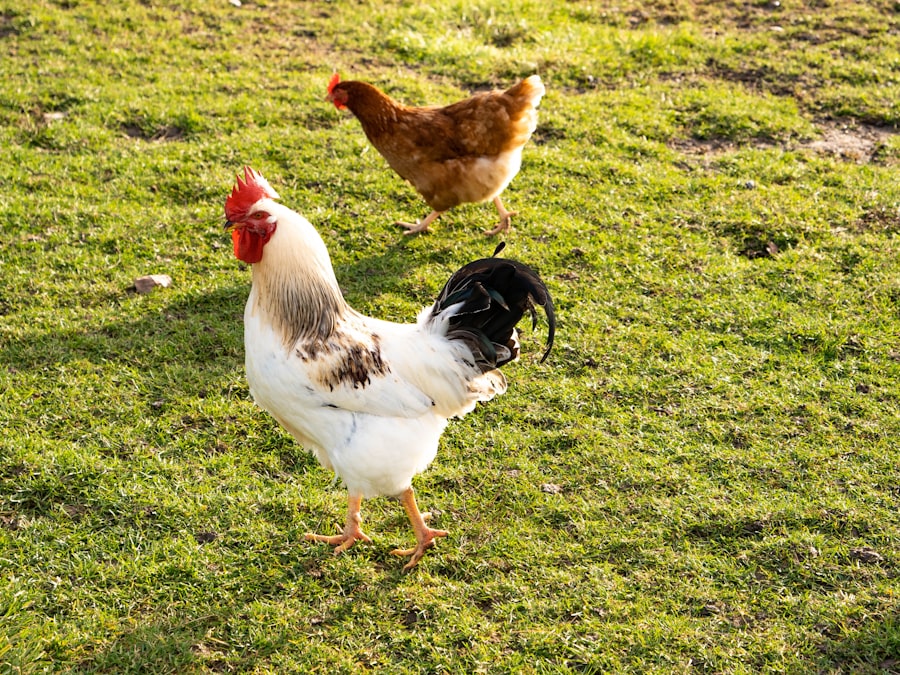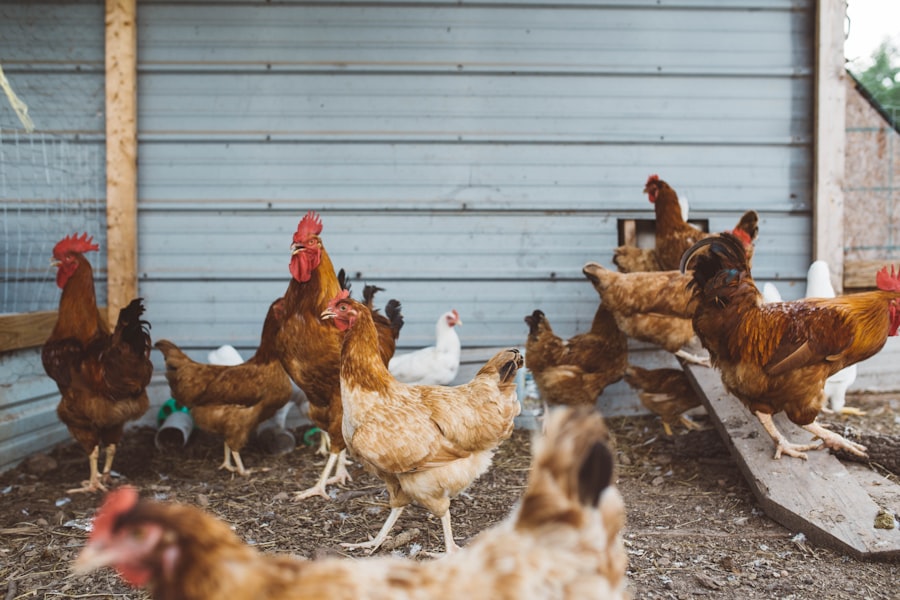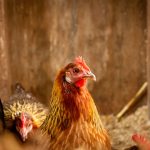Chickens are commonly believed to possess the ability to keep their heads perfectly still while their bodies move. This misconception has been widely circulated through various media channels and popular culture, leading to a widespread misunderstanding of chicken anatomy and behavior. However, scientific observation reveals that this perception is not entirely accurate.
This article aims to examine the anatomy and behavior of chickens to provide a factual explanation of their head movements. By analyzing the structure of a chicken’s neck and head, their natural locomotion patterns, and the underlying physiological mechanisms, we can gain a more accurate understanding of chicken biomechanics. This investigation will help clarify why the myth of head-steady chickens has persisted and demonstrate why it is not supported by scientific evidence.
Table of Contents
- 1 The Anatomy of a Chicken’s Neck and Head
- 2 Observations of Chickens’ Head Movements
- 3 Explanations for the Perception of Head-Steady Chickens
- 4 The Role of Vestibulo-Ocular Reflex in Chicken Head Stability
- 5 The Importance of Head Stability for Chickens
- 6 Debunking the Myth of Head-Steady Chickens
- 7 FAQs
Key Takeaways
- Chickens are often perceived as having steady heads, but this is actually a myth.
- The anatomy of a chicken’s neck and head allows for a wide range of movement.
- Observations show that chickens actually move their heads quite frequently.
- The vestibulo-ocular reflex plays a key role in stabilizing a chicken’s head.
- Head stability is important for chickens to maintain visual acuity and balance.
The Anatomy of a Chicken’s Neck and Head
To understand the myth of head-steady chickens, it is essential to first examine the anatomy of a chicken’s neck and head. Chickens, like all birds, have a unique skeletal structure that allows for a wide range of movement. Their necks are composed of numerous small vertebrae, which are connected by flexible joints and surrounded by muscles and tendons.
This design enables chickens to exhibit a remarkable degree of flexibility and agility in their neck movements. Additionally, a chicken’s head is relatively small and lightweight, allowing for swift and precise movements. When considering these anatomical features, it becomes evident that chickens are capable of dynamic and fluid head movements, contrary to the notion of head-steadiness.
Furthermore, the eyes of a chicken are positioned on the sides of their head, providing them with a wide field of vision. This placement allows chickens to monitor their surroundings for potential threats or sources of food without needing to move their heads excessively. The combination of their flexible necks and lateral eye placement enables chickens to engage in constant visual scanning, contributing to the misconception of head-steadiness.
However, as we will explore in the following sections, chickens do indeed move their heads regularly as part of their natural behavior.
Observations of Chickens’ Head Movements

Contrary to the myth of head-steady chickens, careful observation of these birds reveals that they exhibit a wide range of head movements in various contexts. When foraging for food, chickens frequently peck at the ground and raise their heads to swallow, necessitating significant head movements. Additionally, during social interactions, chickens engage in various displays and communication signals that involve head movements, such as bobbing, pecking, and tilting.
These behaviors demonstrate that chickens are far from being head-steady and instead rely on their flexible necks to engage in diverse movements. Moreover, when chickens are alert or alarmed, they display rapid and pronounced head movements to survey their surroundings and assess potential threats. This heightened vigilance is essential for their survival in the wild and reflects the dynamic nature of their head movements.
Overall, these observations dispel the myth of head-steady chickens and highlight the active role that their heads play in everyday activities.
Explanations for the Perception of Head-Steady Chickens
The perception of head-steady chickens may stem from several factors, including the relatively subtle nature of their head movements and the rapidity with which they can reorient their heads. Additionally, when chickens are focused on a specific task or object, such as pecking at food or engaging in social interactions, their head movements may appear more subdued compared to other animals. This subdued appearance could contribute to the misconception of head-steadiness.
Furthermore, the widespread dissemination of this myth through media and popular culture has likely reinforced the perception of head-steady chickens in the public consciousness. Images and depictions of chickens with seemingly motionless heads have perpetuated this misconception, despite the reality of their dynamic head movements. By examining these factors, we can better understand why the myth of head-steady chickens has persisted and why it is important to debunk it through scientific inquiry.
The Role of Vestibulo-Ocular Reflex in Chicken Head Stability
One crucial aspect that contributes to the stability of a chicken’s head during movement is the vestibulo-ocular reflex (VOR). The VOR is a neurological mechanism that enables animals to stabilize their gaze and maintain visual acuity during head movements. In chickens, the VOR plays a vital role in stabilizing their vision as they navigate their environment.
When a chicken moves its head, the VOR generates compensatory eye movements that counteract the head’s motion, allowing the chicken to maintain a stable visual field. This reflexive mechanism is essential for chickens to effectively scan their surroundings for food, predators, and other stimuli while on the move. The coordination between their head movements and visual stability facilitated by the VOR underscores the dynamic nature of a chicken’s head control.
By understanding the role of the VOR in chicken head stability, we can appreciate the intricate physiological mechanisms that contribute to their overall agility and adaptability.
The Importance of Head Stability for Chickens

While debunking the myth of head-steady chickens is crucial for an accurate understanding of these birds’ behavior, it is equally important to recognize the significance of head stability for chickens. As mentioned earlier, chickens rely on their visual acuity to detect potential threats and locate food sources in their environment. The ability to maintain stable vision while moving their heads is essential for their survival and overall well-being.
Additionally, head stability contributes to a chicken’s overall coordination and balance, enabling them to navigate uneven terrain and engage in complex motor behaviors such as flying and perching. By maintaining stable vision during these activities, chickens can effectively assess their surroundings and execute precise movements. Therefore, while debunking the myth of head-steady chickens, it is essential to acknowledge the importance of head stability in facilitating their daily activities and ensuring their ecological success.
Debunking the Myth of Head-Steady Chickens
In conclusion, the myth of head-steady chickens has persisted due to misconceptions about their anatomical capabilities and natural behaviors. Through an examination of a chicken’s neck and head anatomy, observations of their head movements, and an exploration of the vestibulo-ocular reflex, we have debunked this myth and highlighted the dynamic nature of a chicken’s head control. By dispelling this misconception, we can foster a more accurate understanding of chickens’ behavior and physiology.
Moving forward, it is essential to appreciate the agility and adaptability that chickens possess, as well as the intricate mechanisms that enable them to maintain stable vision during movement. By recognizing the complexity of a chicken’s head control and its importance for their survival, we can cultivate greater respect and admiration for these remarkable birds. Debunking myths such as head-steady chickens allows us to embrace a more nuanced perspective on animal behavior and promote scientific literacy within our communities.
If you’re interested in learning more about the behavior of chickens, you might want to check out this article on The Chicken Coop Country Diner. It provides valuable insights into the daily habits and routines of chickens, which could shed some light on whether or not they really keep their head still.
FAQs
What is the myth about chickens keeping their head still?
The myth suggests that chickens can keep their head still while their body moves, due to a stabilizing mechanism in their neck.
Is there any truth to the myth?
No, there is no scientific evidence to support the claim that chickens can keep their head still while their body moves.
How do chickens actually move their heads?
Chickens move their heads in a coordinated manner with their body, just like other birds and animals. They do not have the ability to keep their head still while their body is in motion.
What are some common misconceptions about chicken behavior?
Some common misconceptions about chicken behavior include their ability to keep their head still, their intelligence, and their social behavior. It is important to rely on scientific evidence and research when understanding animal behavior.
Meet Walter, the feathered-friend fanatic of Florida! Nestled in the sunshine state, Walter struts through life with his feathered companions, clucking his way to happiness. With a coop that’s fancier than a five-star hotel, he’s the Don Juan of the chicken world. When he’s not teaching his hens to do the cha-cha, you’ll find him in a heated debate with his prized rooster, Sir Clucks-a-Lot. Walter’s poultry passion is no yolk; he’s the sunny-side-up guy you never knew you needed in your flock of friends!







